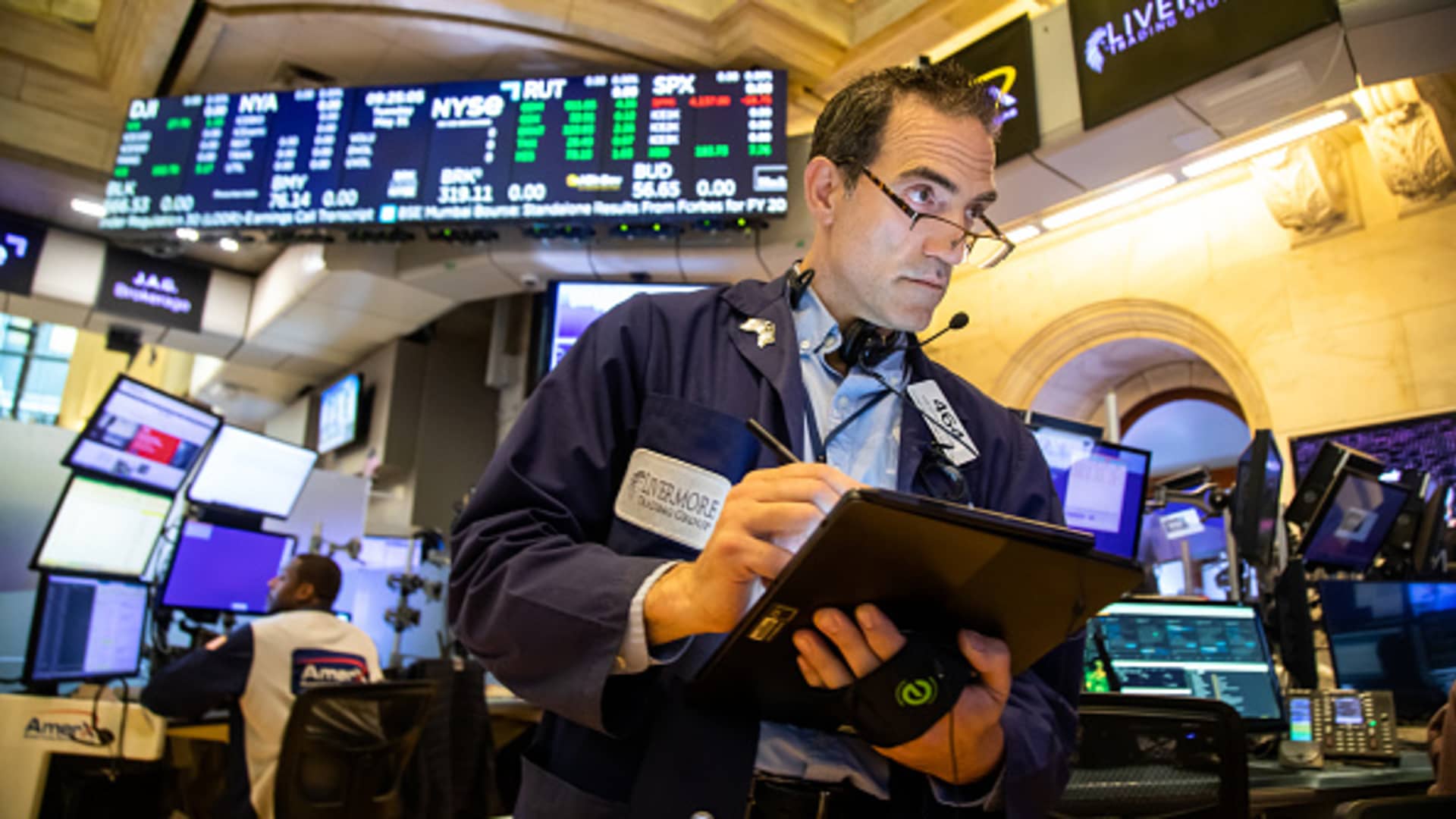
Here are the most important news, trends and analysis that investors need to start their trading day:
1. Dow futures rise as Wall Street begins June trading
A trader works on the floor of the New York Stock Exchange (NYSE) in New York, US, on Tuesday, May 31, 2022.
Michael Nagle | Bloomberg | Getty Images
Dow futures rose Wednesday morning, as Wall Street begins a new month of trading following a volatile May. Despite that turbulence, the blue chip Dow Jones Industrial Average and the S&P 500 ultimately finished the month essentially flat. The tech-heavy Nasdaq Composite slid 2.05% in May, its fourth negative month in five, as investors balance concerns about high inflation, the Federal Reserve’s response to it and the pace of economic growth. Stocks retreated Tuesday, after being closed Monday for the Memorial Day holiday. The Dow lost about 223 points, or 0.7%, on Tuesday while the broad S&P 500 declined 0.6%. The Nasdaq fell 0.4%. The major U.S. stock indexes are down considerably from their all-time highs. The Nasdaq is 25.5% below its November peak. The S&P 500 and Dow, which both notched their records in early January, are down 14.25% and 10.7%, respectively, from those highs.
2. Oil prices gain; OPEC+ reportedly thinking about suspending Russia from supply deal
Oil pumping jacks, also known as “nodding donkeys,” in a Rosneft Oil oilfield near Sokolovka village, in the Udmurt Republic, Russia, on Friday, Nov. 20, 2020.
Andrey Rudakov | Bloomberg | Getty Images
Oil prices were higher Wednesday, as market participants digest a Wall Street Journal report that some OPEC+ members are considering whether to suspend Russia from the energy alliance’s production deal. Crude futures settled lower Tuesday following the publication of the Journal’s report, giving up gains earlier in the session. On Wednesday, U.S. benchmark West Texas Intermediate crude rose roughly 1.3% to about $116.20 per barrel. Brent crude, the international benchmark, was up by about 1.4% to around $117.20 per barrel. Oil prices have soared this year, as Western sanctions on Russian crude have exacerbated existing concerns about tight supply. Russia’s Energy Ministry and OPEC did not respond to CNBC’s request for comment about the Journal’s report. OPEC and non-OPEC oil producers have a policy meeting scheduled for Thursday.
3. Salesforce earnings top estimates, shares jump
Signage on a Saleforce office building in San Francisco, California, U.S., on Tuesday, Feb. 23, 2021.
David Paul Morris | Bloomberg | Getty Images
Salesforce shares were up more than 8% in premarket trading the morning after the enterprise software maker reported fiscal first-quarter results that topped analyst estimates. Dow component Salesforce earned an adjusted 98 cents per share on revenue of $7.41 billion. Wall Street had expected per-share earnings of 94 cents on revenue of $7.38 billion, according to Refinitiv. Salesforce’s forward guidance was mixed. Its fiscal second-quarter projections for earnings and sales came in lighter than analysts forecast, as did its lowered full-year revenue outlook. However, Salesforce boosted its full fiscal-year adjusted earnings guidance to between $4.74 and $4.76 per share, better than the EPS of $4.65 analysts expected. Salesforce shares have been clobbered year to date, down about 36% as of Tuesday’s close, as high-multiple tech stocks fell out of favor. Investors had been anticipating Salesforce’s quarterly numbers to get a sense of how enterprise spending is holding up despite concerns about an economic slowdown.
4. HP Inc. beats estimates, helped by strong corporate demand
Enrique Lores, CEO, HP
Scott Mlyn | CNBC
HP Inc. posted better-than-expected fiscal second-quarter results after Tuesday’s close, as demand from corporate customers helped offset softer consumer purchases. Shares of the PC maker were basically flat in before-the-bell trading Wednesday. HP earned an adjusted $1.08 per share on sales of $16.49 billion, eclipsing the per-share earnings of $1.05 and $16.17 billion in revenue analysts expected, according to Refinitiv. HP’s total unit shipments in the quarter declined year over year in both of its primary segments: personal systems and printing. However, personal systems revenue rose 9% to $11.5 billion, aided by 18% growth in its commercial business as companies upgraded desktops and workstations. HP CEO Enrique Lores said on the earnings conference call that while consumer demand has softened from its Covid-fueled increase, it remains above pre-pandemic levels. HP’s quarterly report Tuesday was its first since Warren Buffett’s Berkshire Hathaway disclosed a major stake in the company.
5. Mortgage demand slides to lowest level since late 2018
A for sale sign is posted in front of a home for sale on March 18, 2022 in San Rafael, California.
Justin Sullivan | Getty Images
Mortgage demand last week hit its lowest level since December 2018, according to the Mortgage Bankers Association’s seasonally adjusted index. Mortgage applications to buy a house declined 1% last week compared with the previous week, the MBA said, and volume was down 14% year over year. Home loan refinance applications saw bigger declines, falling 5% for the week. They were 75% lower than the same week in 2021, when mortgage rates hovered around record lows. The MBA’s data Wednesday offers additional insight into the state of the closely watched housing market. Mortgage rates have increased significantly so far this year, adding to affordability challenges given rising home prices. In March, home prices were nearly 21% higher than a year ago, according to the S&P CoreLogic Case-Shiller Home Price Index, which was released Tuesday.
— CNBC’s Sam Meredith and Diana Olick contributed to this report.
— Sign up now for the CNBC Investing Club to follow Jim Cramer’s every stock move. Follow the broader market action like a pro on CNBC Pro.
from Stock Market News – My Blog https://ift.tt/MrvOJyI
via IFTTT

No comments:
Post a Comment